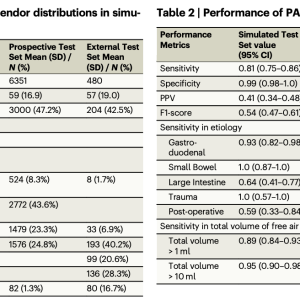

Delays or errors in diagnosing pneumoperitoneum, with air outside the intestines within the peritoneal cavity, can severely impact patient survival and health outcomes. In adults, most cases result from a perforated viscus, with up to 90% needing surgical intervention. While CT scans are the preferred diagnostic tool for their high accuracy, interpretation delays are common in busy emergency departments. Variability in diagnostic confidence and interpretation between residents and attending radiologists can contribute to delays and misdiagnoses. AI has shown potential in improving speed and accuracy in medical imaging analysis, though its effectiveness for pneumoperitoneum detection depends on careful dataset selection and ongoing refinement.
Researchers from Cedars-Sinai Medical Center and Far Eastern Memorial Hospital developed a deep-learning model to detect pneumoperitoneum in CT images. Trained on data from Far Eastern Memorial Hospital and validated on recent scans, the model achieved high sensitivity (0.81–0.83) and specificity (0.97–0.99) across retrospective, prospective, and external datasets, with sensitivity improving to 0.92–0.98 when excluding cases with minimal free air. Additionally, they introduced PACT-3D, a 3D UNet-based model optimized for pneumoperitoneum segmentation. PACT-3D captures spatial details across multiple planes, offering accurate, patient-level predictions with pixel-level segmentation, demonstrating strong performance in simulated and real-world scenarios.
The study adhered to the STARD guidelines and was approved by Institutional Review Boards at Far Eastern Memorial Hospital (IRB 111086-F) and Cedars-Sinai Medical Center (IRB STUDY00003494). The model operated without altering standard patient care during the prospective evaluation phase. Data collected during this period, including model predictions, were later extracted for analysis. The dataset included contrast-enhanced abdominal CT scans from Far Eastern Memorial Hospital, gathered between 2012 and 2021. Each scan was reviewed to confirm the presence or absence of pneumoperitoneum, with two radiologists verifying positive cases. Real-world model performance was assessed from December 2022 to May 2023 using prospective data from the same facility.
Data acquisition involved CT scans containing contrast, scanned in the axial plane with a 5 mm slice thickness and abdominal coverage. NLP methods were employed to identify relevant reports, and test sets with a 5:1:1 ratio, avoiding data duplication across sets. Manual annotations of pneumoperitoneum were completed by experienced radiologists, followed by a secondary review. A 3D U-Net model was developed for segmentation, integrating a contracting path for contextual understanding and an expanding path for detailed localization. Data augmentation and a combined Dice and Focal loss function were used to address class imbalance, with training conducted on an Nvidia RTX A6000 GPU. An adaptive moment estimation (Adam) optimizer and a cosine annealing learning rate scheduler enhanced model training stability and convergence.
The study analyzed 139,781 abdominal CT scans, with 973 showing pneumoperitoneum, divided into training, validation, and test sets at a 5:1:1 ratio. The model’s performance was validated with a prospective set of 6,351 scans from December 2022 to May 2023. The 3D U-Net model showed an F1-score of 0.54 in the simulated set and 0.58 in the prospective set, with high sensitivity and specificity. In external validation at Cedars-Sinai Medical Center, it achieved an F1-score of 0.80. Sensitivity increased with higher free air volumes, and positive predictions correlated with a higher rate of urgent surgeries.
The study presents PACT-3D, a 3D U-Net-based deep learning model designed to detect pneumoperitoneum in abdominal CT scans. Despite diverse scanner models and geographical variations, PACT-3D showed robust performance across various test sets, maintaining high sensitivity and specificity. The model’s 3D architecture enables improved differentiation of free air from bowel gas, supporting reliable detection, especially in critical cases needing immediate intervention. Although effective, the model requires refinement to enhance sensitivity for smaller volumes of free air. PACT-3D demonstrates strong potential to improve diagnostic efficiency in emergency care, potentially enhancing clinical outcomes.
Check out the Paper. All credit for this research goes to the researchers of this project. Also, don’t forget to follow us on Twitter and join our Telegram Channel and LinkedIn Group. If you like our work, you will love our newsletter.. Don’t Forget to join our 55k+ ML SubReddit.
[AI Magazine/Report] Read Our Latest Report on ‘SMALL LANGUAGE MODELS‘
The post PACT-3D: A High-Performance 3D Deep Learning Model for Rapid and Accurate Detection of Pneumoperitoneum in Abdominal CT Scans appeared first on MarkTechPost.